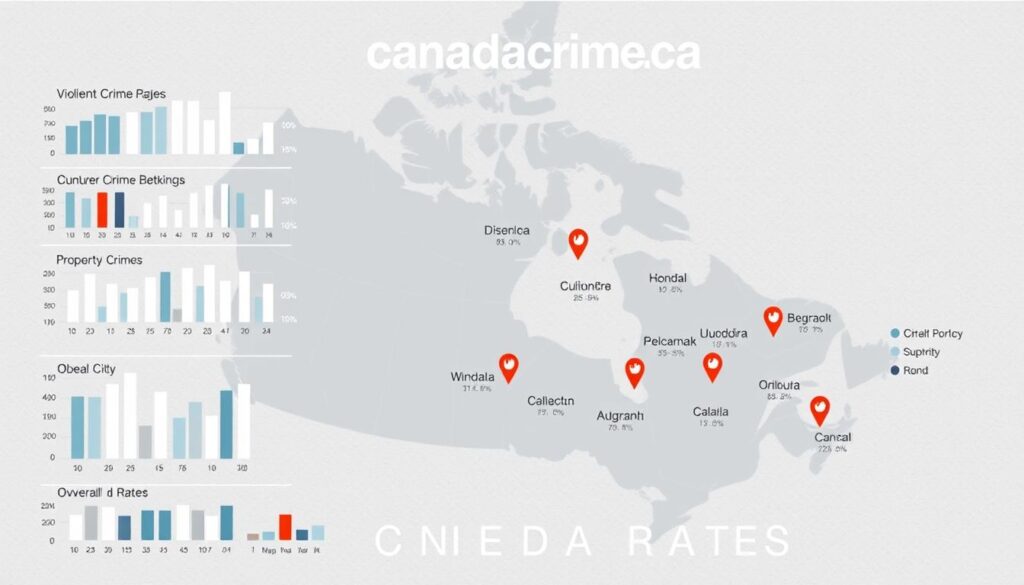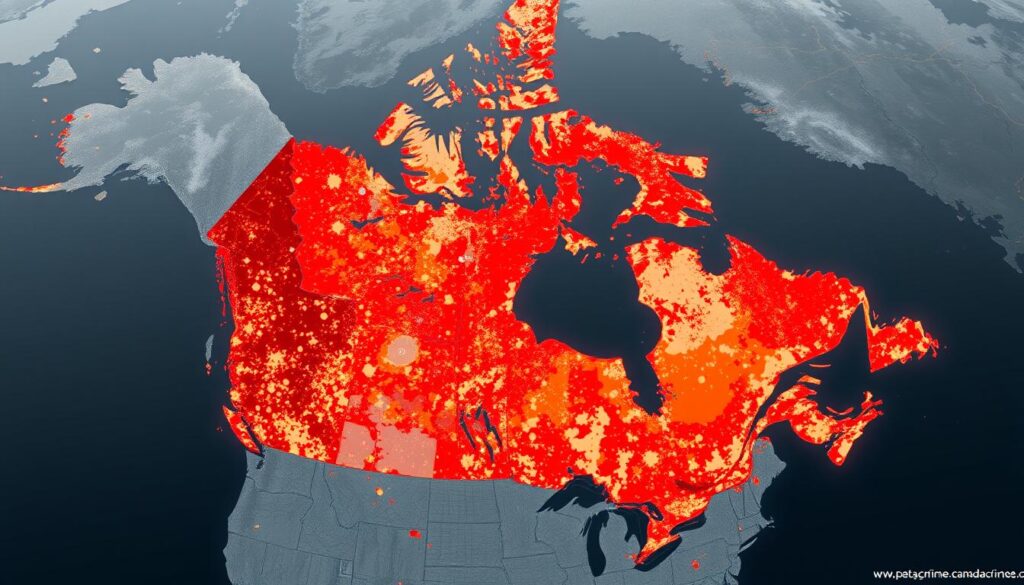Canada’s cities are often regarded as safe havens, but a closer look at crime statistics reveals a more complex picture. With a crime index that varies significantly across different urban centers, understanding the nuances of public safety is crucial.
The crime index measures the overall level of crime in a city on a scale from 0 to 100, with higher values indicating higher crime rates. Conversely, the safety index reflects safer conditions with higher values. By examining these indices and the latest data, we can gain insights into the factors contributing to crime in various cities across Canada.
This comprehensive guide will explore the current state of crime in Canada, analyzing both the most dangerous and safest cities based on recent statistics. By understanding these trends, residents and policymakers can work together to enhance safety and address crime concerns.
Understanding Crime Rates in Canada
Understanding crime rates in Canada requires a nuanced approach, considering multiple data sources and measurement systems. Crime data in Canada is primarily collected by Statistics Canada through the Uniform Crime Reporting (UCR) Survey. This standardized methodology allows for meaningful comparisons between different jurisdictions.

How Crime Statistics Are Measured in Canada
Crime rates in Canada are typically expressed as incidents per 100,000 population, providing a proportional measure that accounts for population differences. The Crime Severity Index (CSI) is another critical metric, weighing offenses based on their seriousness to offer a more nuanced view than raw crime counts. This approach enables a more accurate understanding of crime rates and their impact on communities.
The UCR Survey collects data on various crimes, which are then used to calculate the CSI. This index is crucial for understanding the relative severity of crimes across different regions in Canada.
Crime Index vs. Safety Index Explained
The Crime Index and Safety Index are two complementary metrics used to assess urban security. The Crime Index measures the level of crime in a given area, while the Safety Index reflects how safe the area is perceived to be. There is an inverse relationship between these two indices; as the Crime Index increases, the Safety Index decreases, and vice versa.
Perception-based indices, such as the Safety Index, supplement official crime statistics by capturing public sentiment about safety, which may differ from reported crime data. Understanding these measurement systems is crucial for accurately interpreting crime statistics and avoiding misrepresentations of urban safety levels.
Canadian City Crime Rates: The Most Dangerous Cities in 2025

A closer look at Canadian city crime rates in 2025 shows that some metropolitan areas are grappling with significant crime challenges. The latest data highlights several cities that are facing concerning crime trends.
Surrey: Canada’s Highest Crime Index
Surrey, British Columbia, currently holds the highest crime index in Canada at 64.7, with concerns centered around property crimes, violent offenses, and gang-related activities that have intensified with rapid urbanization. The city’s crime index is a significant concern for both residents and law enforcement.
Kelowna and Sudbury: Rising Concerns
Kelowna has experienced a concerning upward trend in its crime index, rising from 61.6 in 2024 to 62.1 in 2025, with particular challenges in theft, vandalism, and drug-related crimes affecting this popular tourist destination. Sudbury continues to struggle with elevated crime rates (61.9 crime index), largely attributed to substance abuse issues and socioeconomic challenges that persist despite community intervention efforts.
Winnipeg and Sault Ste. Marie: Persistent Challenges
Winnipeg maintains a consistently high crime index of 60.5, facing ongoing challenges with both property crimes and violent offenses despite targeted initiatives focused on youth engagement and poverty reduction. Sault Ste. Marie rounds out the top five most dangerous cities with a crime index of 60.2, where drug-related crimes remain a significant concern despite the city’s tight-knit community structure.
Other High-Risk Urban Centers
Other high-risk urban centers include Hamilton (55.8), Brampton (55.3), and Kamloops (54.8), each experiencing distinct patterns of criminal activity influenced by their unique demographic and economic circumstances. Many of these high-crime cities share common challenges including rapid population growth, economic pressures, and substance abuse issues that contribute to their elevated crime indices. The geographic distribution of these dangerous cities spans multiple provinces, indicating that crime challenges are not confined to any single region of Canada.
The Safest Canadian Cities by Crime Rate
While crime rates vary across Canadian cities, some urban areas have consistently demonstrated high levels of safety. For those interested in exploring Canada’s crime landscape further, visiting Canada Crime can provide valuable insights.

Quebec City: Canada’s Safety Leader
Quebec City stands out as Canada’s safety leader, boasting a crime index of 22.2 and a safety index of 77.8. This is attributed to its strong emphasis on cultural cohesion and community-oriented policing strategies. The city’s low crime rate makes it an exemplary model for other urban areas.
Oakville and Burlington: Suburban Safety
Oakville and Burlington are notable examples of suburban safety. Oakville has a crime index of 26.1, while Burlington’s is 29.7. Both cities benefit from well-planned neighborhoods and active community participation in safety initiatives, contributing to their family-friendly environments.
Ottawa and Montreal: Safe Metropolitan Areas
Ottawa, the capital city, and Montreal, a major urban center, demonstrate that large metropolitan areas can achieve high safety standards. Ottawa has a crime index of 31.3, and Montreal’s is 32.8. Both cities have achieved this through transparent governance and strategic allocation of resources to public safety. Ottawa’s declining crime index is a testament to its effective safety measures.
These safe cities share common characteristics, including strong community bonds, economic stability, and effective policing strategies. The geographic distribution of Canada’s safest cities across multiple provinces suggests that regional policy approaches may influence safety outcomes. Moreover, the stability of their safety indices over time indicates that their approaches to crime prevention are sustainable.
Types of Crime Across Canadian Regions
Understanding the types of crime across Canadian regions is crucial for developing effective crime prevention strategies. Canada’s diverse regions face unique crime challenges, influenced by factors such as urbanization, socioeconomic conditions, and geographical characteristics.
Violent Crime Distribution
Violent crime distribution across Canada shows significant regional variation. Prairie provinces like Manitoba and Saskatchewan experience higher rates of violent offenses compared to the national average. Major urban centers often report higher absolute numbers of violent crimes, but smaller cities like Thompson, Manitoba, and North Battleford, Saskatchewan, show concerning per-capita violent crime rates. For instance, Manitoba has one of the highest rates of violent crime, with a rate of 1,443.41 per 100,000 population, significantly higher than the national average.
| Province | Violent Crime Rate (per 100,000) |
|---|---|
| Manitoba | 1,443.41 |
| Saskatchewan | 1,215.91 |
| British Columbia | 765.41 |
Property Crime Patterns
Property crime patterns reveal that British Columbia faces particular challenges with theft, break-and-enter incidents, and auto theft. Cities like Surrey and Kelowna experience some of the highest rates of property crime in the country. The relationship between urban density and property crime is complex, with suburban areas sometimes being targeted due to perceived affluence and accessibility to major transportation routes.

Regional Crime Specialization
Regional crime specialization is evident across Canada, with northern communities facing unique challenges related to isolation and limited resources. Border communities contend with cross-border smuggling and related offenses. Drug-related crimes show distinct regional patterns, with major port cities like Vancouver and Halifax serving as entry points for illicit substances. White-collar crimes and fraud tend to concentrate in financial centers like Toronto and Montreal.
Understanding these regional crime patterns helps law enforcement agencies allocate resources effectively and develop targeted prevention strategies. By recognizing the specific challenges faced by different Canadian communities, authorities can better address the root causes of crime and improve public safety.
The Canadian Criminal Code: Understanding Crime Classification
Understanding the Canadian Criminal Code is essential for grasping how crimes are classified and reported across the country. The Code serves as the comprehensive federal legislation that codifies most criminal offenses in Canada, establishing a standardized framework for defining and prosecuting criminal behavior across all provinces and territories.

Major Categories in the Criminal Code
The Criminal Code categorizes crimes into several major categories, including crimes against the person, crimes against property, and crimes against public order. Crimes against the person include violent crimes such as homicide, assault, and sexual offenses. Crimes against property encompass theft, fraud, and mischief, while crimes against public order include weapons offenses and disorderly conduct.
- Crimes against the person: homicide, assault, sexual offenses
- Crimes against property: theft, fraud, mischief
- Crimes against public order: weapons offenses, disorderly conduct
How Crimes Are Classified and Reported
The Criminal Code distinguishes between indictable offenses, summary conviction offenses, and hybrid offenses. Indictable offenses are more serious crimes with potentially greater penalties, while summary conviction offenses are less serious with more limited penalties. Hybrid offenses allow the Crown to elect the mode of prosecution. The classification system directly impacts how crimes are reported in national statistics Canada uses these categories to organize and present crime data consistently across jurisdictions.
Understanding the Criminal Code classification system is crucial for interpreting crime statistics accurately, as changes in legislation can significantly impact reported crime rates without necessarily reflecting changes in actual criminal behavior. The Code also establishes sentencing principles and guidelines that influence how offenders are processed through the justice system, affecting rehabilitation, deterrence, and public safety.
Factors Influencing Crime Rates in Canadian Cities
Several key factors contribute to the shifts in crime indices across Canadian cities. Understanding these factors is essential for developing effective strategies to mitigate crime and enhance public safety.
Urbanization and Population Growth
Urbanization and population growth are significant factors influencing crime rates in Canadian cities. Cities like Surrey and Brampton have experienced rapid population growth, leading to increased social and economic pressures. As these cities expand, the development of social infrastructure and community services often lags behind, creating complex challenges for maintaining social cohesion and preventing crime.
- Rapid population growth can lead to higher crime rates as municipal resources are stretched thin.
- Community bonds are still forming among diverse new residents, affecting social cohesion.
Economic Conditions and Inequality
Economic conditions play a crucial role in shaping crime rates in Canadian cities. Research has consistently shown correlations between economic downturns, unemployment rates, and increases in certain types of criminal activity, particularly property crimes and theft. Income inequality within cities also creates conditions conducive to crime, as visible disparities in wealth and opportunity can foster social tension and disengagement from mainstream social norms and values.
Economic instability can exacerbate crime in urban centers.
Substance Abuse and Mental Health Challenges
Substance abuse represents a major driver of criminal activity across Canadian cities. Addiction issues frequently lead to property crimes to support drug habits and violent incidents related to drug distribution networks. Mental health challenges intersect with criminal justice issues, as inadequate mental health services often result in people with untreated conditions encountering law enforcement rather than healthcare providers during moments of crisis.

Crime Prevention Strategies in Canadian Communities
Crime prevention in Canada involves a combination of community-based programs, law enforcement strategies, and technological advancements. To effectively address the rising crime rates, various stakeholders are coming together to implement comprehensive safety measures.
Community-Based Prevention Programs
Community-based prevention programs form the backbone of Canada’s crime reduction efforts. Initiatives such as Neighborhood Watch, community policing committees, and youth mentorship programs foster a shared responsibility for public safety. Early intervention programs targeting at-risk youth have shown significant success in reducing future criminal behavior. Cities like Ottawa and Quebec City are investing in school-based initiatives and recreational opportunities to provide positive alternatives to delinquency.
- Neighborhood Watch programs encourage community vigilance.
- Youth mentorship programs provide guidance and support.
- Community policing committees enhance cooperation between law enforcement and the public.
Law Enforcement Initiatives
Law enforcement agencies across Canada are adopting evidence-based policing models that focus on crime hotspots and repeat offenders. Specialized police units addressing specific crime types, such as gang violence and domestic abuse, are developing expertise and community connections that enhance their effectiveness. Cities like Surrey and Hamilton are increasing police presence in high-crime areas to deter criminal activity.
- Evidence-based policing models optimize resource allocation.
- Specialized units tackle specific crime types effectively.
- Increased policing in high-crime areas enhances public safety.
Technology and Surveillance in Crime Prevention
Technology plays a crucial role in modern crime prevention strategies. Many Canadian cities are implementing CCTV networks, automated license plate readers, and crime mapping software to identify patterns and deploy resources proactively. These technological advancements help law enforcement agencies stay ahead of criminal activity and improve urban safety.

- CCTV networks enhance surveillance and monitoring.
- Automated license plate readers aid in vehicle tracking.
- Crime mapping software helps in strategic resource deployment.
Year-Over-Year Crime Trends in Canada
The year-over-year crime data for Canada indicates a complex picture of safety across different cities and regions. While the national crime rate has shown modest fluctuations, specific areas have experienced more dramatic changes reflecting local conditions and challenges.

Notable Changes in Crime Statistics
Several Canadian cities have witnessed significant shifts in their crime indices. For instance, Kelowna’s crime index increased slightly, maintaining its position as one of the cities with higher crime rates. In contrast, Hamilton’s crime index rose by 0.9 points, moving it higher on the list. Cities like Sault Ste. Marie and Regina saw minimal changes, maintaining their positions in the rankings.
Notably, suburban areas such as Brampton and Kamloops experienced significant increases in their crime indices, indicating growing safety concerns in these regions.
Emerging Crime Patterns and Concerns
Year-over-year crime data highlights emerging patterns and concerns. British Columbia has seen a concerning increase in property crime rates, particularly in cities like Surrey and Kelowna, where property offenses have risen by approximately 5-10% annually.
Additionally, cybercrime has emerged as the fastest-growing category of criminal activity, with year-over-year increases exceeding 15% nationally. Drug-related offenses have also shown shifting patterns, with decreases in cannabis-related charges but concerning increases in opioid and methamphetamine-related crimes.
Conclusion: The Future of Public Safety in Canadian Cities
The 2025 crime index reveals significant trends in urban safety across Canada. Cities like Surrey and Kelowna face rising crime rates, while Quebec City and Oakville set safety benchmarks.
Addressing crime’s root causes and leveraging technology will keep Canada safe. Factors like climate change and demographic shifts will influence crime rates. Community-centered policing and data-driven approaches will be crucial.
Safe cities’ models can be adapted to higher-crime areas. Public engagement in safety initiatives will drive sustainable improvements, ensuring Canada remains a safe country.

